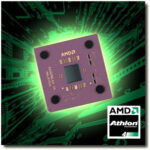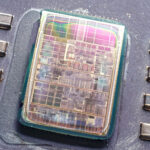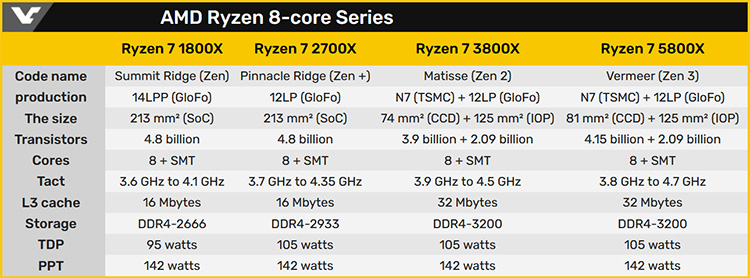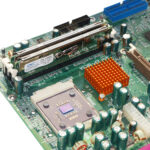Introduction
 The AMD Socket 462 or Socket A, was a rather interesting and long-lasting CPU Socket. The first models of Socket 462 processors appeared in the summer of 2000, they were just the first representatives of the AMD Athlon “Thunderbird” in a ceramic case with a clock frequency of 600 MHz, and with 256 KB of L2 cache , an effective system bus frequency of 200 MHz, with MMX support instructions and their own 3DNow !, of course, there was no question of any SSE in those days. Produced ” Thunderbirds” at 180 nm. tech process, the operating voltage was set in the range of 1.70-1.75 volts, and the maximum heat dissipation was 72 watts for the older model 1400 MHz versions. These replaced the old Slot A cartridge based Thunderbirds, made possible by the L2 cache being moved on die instead of off die (in similar fashion to Intel’s Coppermine Pentium IIIs moving to S370 from Slot 1).
The AMD Socket 462 or Socket A, was a rather interesting and long-lasting CPU Socket. The first models of Socket 462 processors appeared in the summer of 2000, they were just the first representatives of the AMD Athlon “Thunderbird” in a ceramic case with a clock frequency of 600 MHz, and with 256 KB of L2 cache , an effective system bus frequency of 200 MHz, with MMX support instructions and their own 3DNow !, of course, there was no question of any SSE in those days. Produced ” Thunderbirds” at 180 nm. tech process, the operating voltage was set in the range of 1.70-1.75 volts, and the maximum heat dissipation was 72 watts for the older model 1400 MHz versions. These replaced the old Slot A cartridge based Thunderbirds, made possible by the L2 cache being moved on die instead of off die (in similar fashion to Intel’s Coppermine Pentium IIIs moving to S370 from Slot 1).

Thunderbird die exposed
The last representative that was designed for Socket 462 was AMD Athlon XP+ using the “Barton” core, released in early 2003, which retained its position throughout 2004. With “Barton” the ceramic case is a thing of the past, being replaced by a Organic PGA package. The process has decreased to 130 nm, the L2 cache capacity has doubled, the system bus frequency has doubled, and the clock speeds have exceeded 2.2 GHz.
The fastest model had a real frequency of 2200 MHz and a performance rating of 3200+, the operating voltage was 1.65 V, and the TDP was 77 W with a 400FSB. These was also another AXDA3200 with a 333 FSB, this actually clocked slightly faster as 2.333GHz, but was given the same PR rating due to its slightly slower FSB. The processor acquired the first generation SSE instructions, and the motherboards created for it in that day now added support for dual-channel operation of the RAM. If we add here that the first motherboards based on Socket 462 worked with SDRAM memory, and the subsequent ones with DDR-SDRAM, then according to a number of indicators there is a twofold increase in the main characteristics of the platform within the framework of one socket.
Such a funny comparison reminded me of today, where from the time the first generation of AMD Ryzen processors appeared in 2017, until the last (fourth gen), which debuted at the very end of last year (2020), all processors also had one AM4 socket. Ryzen performance gains across all four generations are clearly exemplified by the following slides:


AMD hasn’t had much of a problem with processor support before, although AMD has officially announced that Ryzen 5000 series desktop will only be supported on boards with 400 and 500 series chipsets. Therefore,  on motherboards released for the first generation Ryzen, it will not work to use the latest generation processors in an official way. Although there is information on the network that there are cases of using Ryzen 5000 series processors on motherboards with the older X370 chipset, but the official position of AMD has already been announced above.
on motherboards released for the first generation Ryzen, it will not work to use the latest generation processors in an official way. Although there is information on the network that there are cases of using Ryzen 5000 series processors on motherboards with the older X370 chipset, but the official position of AMD has already been announced above.
In the wake of such analogies, I thought, why not compare the first and the last Athlons for Socket 462 on several motherboards at the same clock frequency, with the same system configuration? You will find out the result of what came out of this by reading this article to the end.
Continuation of the Idea
 The essence of the idea is simple – take the first AMD Athlon based on the “Thunderbird” core with a 200 and 266 MHz system bus and a clock speed of 1 GHz and an AMD Athlon XP representative on the “Barton” core with a similar round frequency of one GHz, and compare them with each other to find out how much the first generation loses to the last one. During the existence of Socket 462, several generations of processors with different cores have changed on it: Thunderbird – Palomino – Thoroughbred – Thorton – Barton. This will be an interesting test of raw architecture improvements of the core. all other things being as equal as they can be.
The essence of the idea is simple – take the first AMD Athlon based on the “Thunderbird” core with a 200 and 266 MHz system bus and a clock speed of 1 GHz and an AMD Athlon XP representative on the “Barton” core with a similar round frequency of one GHz, and compare them with each other to find out how much the first generation loses to the last one. During the existence of Socket 462, several generations of processors with different cores have changed on it: Thunderbird – Palomino – Thoroughbred – Thorton – Barton. This will be an interesting test of raw architecture improvements of the core. all other things being as equal as they can be.
Read More »
 For tests of all processors with a final frequency of 1 GHz, several processor / RAM operating modes were selected: 100/100, 100/133, 133/133, 133/166 MHz, priority was given to modes with the highest RAM frequency.
For tests of all processors with a final frequency of 1 GHz, several processor / RAM operating modes were selected: 100/100, 100/133, 133/133, 133/166 MHz, priority was given to modes with the highest RAM frequency.






